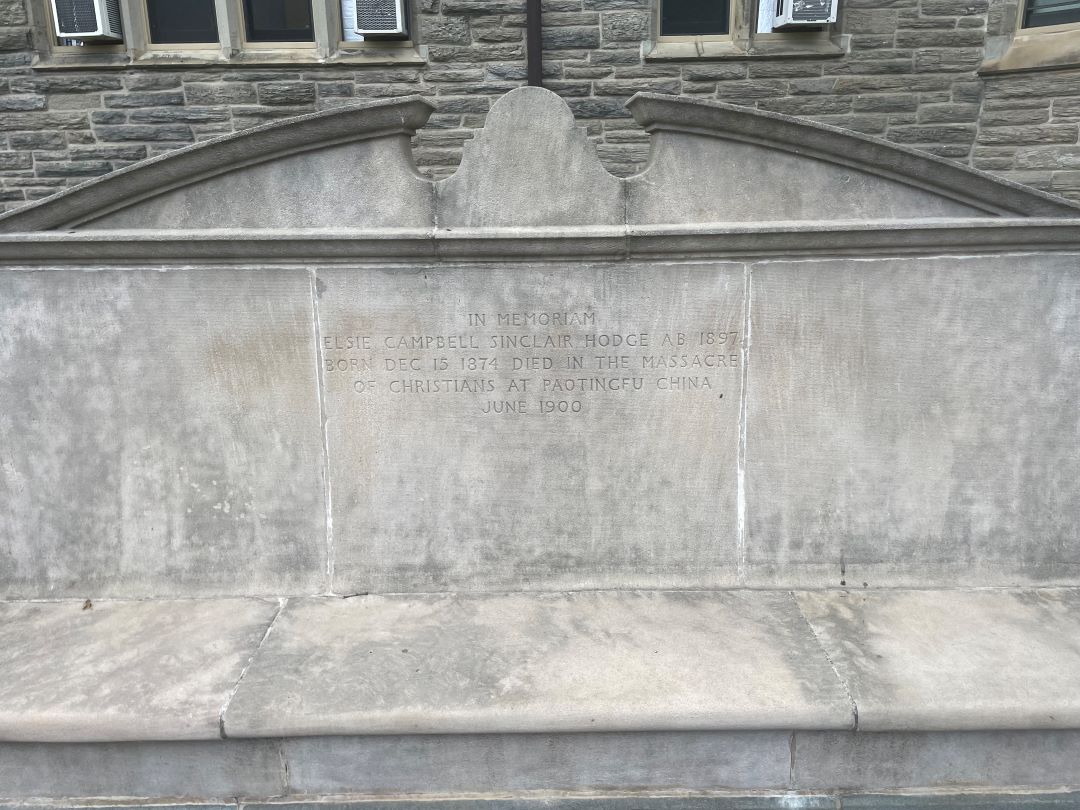This summer’s Who Built Bryn Mawr? internship kicked off on Tuesday, May 30th in the Special Collections reading room.
The interns this year are Yihan Liu (she/her) and Grace Foresman (she/her). They will be researching and curating this year’s project. Allison Mills, College Archivist (she/her) and Carrie Robbins, Curator of Art and Artifacts (she/they) are advising/leading the project. And I, Marion Hamilton (she/her, he/him), am a post-bac advisor/assistant to the project. I was also a Who Built Bryn Mawr? intern last summer, and I am excited to be involved with the project again! This is just a short summary of our first week and the research that has already begun.
We spent Tuesday touring the Special Collections and Archives storage spaces in Canaday and jumping right into some archival research through the Donor Biography Project. We looked through Helen Burwell Chapin’s (Class of 1914) papers to try to learn more about her. She donated a huge amount of Bryn Mawr’s collection of Asian art (her donations are primarily Chinese, Japanese, and Korean art). The Donor Biography Project is seeking to create more complete biographies about donors. Who were they? Why did they donate this art? Why did they have it? How did they acquire it? Where is this art originally from? Who made it (we don’t know for all the items in the collection)?
While we only scratched the surface of information, it was a good introduction to the types of work this project could pursue.
On Wednesday, we started the day with a tour of both the collections storage in Old Library and a few places on campus where objects connected to Asian histories at Bryn Mawr are located. In Old Library, we saw many of the boxes that contained objects donated by Helen Chapin as well as a large amount of Deanery furniture (a lot of items in the Deanery were made internationally, much of it in India, Syria, China, and Japan).
We also saw the Japanese bell hanging on the first floor of Taylor Hall (gifted to the college by Mary Morris), Taft Garden (once M. Carey Thomas’ private garden decorated with art from many places in Asia), and a bench between Denbigh and Guild that was gifted by the Class of 1897 to commemorate Elsie Campbell Sinclair Hodge (Class of 1897), who was a white Christian missionary who was killed in Northern China during the Boxer Rebellion (also called the Yihetuan Movement). These items are just a few examples of places on campus where Bryn Mawr’s history intersects with histories of Asia.

In the afternoon, spurred by the things we saw in the morning, we pulled photos and files about the Deanery from the archives to investigate more about the furniture decorations there and in Taft Garden. We started to find some threads— objects (e.g. a set of Chinese fu dog statues) with uncertain origins and history that might start to uncover how imperialism, European collecting, Bryn Mawr’s history, and these objects intersect. We also met with Alice McGrath, Senior Digital Scholarship Specialist (she/her) to talk about this blog and website design for this year’s project. Next Tuesday we’ll meet with her again to get more into the weeds of learning markdown and how to manage the blog!
On Thursday, our morning was mostly administrative tasks and some more archival research (there are huge lists of everything that was in the Deanery!). After a break to go have coffee and bagels with all the other summer LITS interns and staff, I gave a presentation on last year’s Who Built Bryn Mawr? exhibit and what our process was like last summer.
After lunch, we took a close look at “Bauhaus at Bryn Mawr”, the exhibit currently in the case that will be used for Who Built Bryn Mawr? this summer. Looking at past exhibits, especially in the same space we’ll be using, is so helpful in thinking about how people interact with the space, what organizational strategies work or don’t work, how to catch people’s eyes, and how much space there is for objects.
And Friday….well, Canaday is closed today because of a water main break in Delaware County. Nonetheless, we spent the morning writing and editing blog posts. In the afternoon, we had the pleasure of talking to Amanda Silberling (she/her), a writer from TechCrunch who spoke about writing for the public, doing research on communities outside one’s own and on current social issues, and how to condense research for short-form writing.
This week has already been a whirlwind, but we’ve already found so much worth researching in just a few short days!